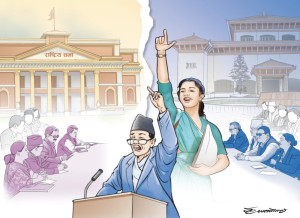Columns
Gender-equal education
Policymakers and activists worried about girls being left behind must look beyond access.
M Niaz Asadullah
Ensuring inclusive, equitable, high-quality education for all is a major pillar of the United Nations Sustainable Development Goals. Three decades ago, fewer girls were in school than boys. Among those girls who were fortunate enough to be enrolled, the majority dropped out early. In many parts of the developing world, social norms and poverty combined to limit girls’ educational and social opportunities. However, improvements over the past 25 years in girls’ enrollment in primary and secondary education have been dramatic, significantly reducing educational gender disparities.
While girls still face extreme exclusion in Sub-Saharan African countries such as Ivory Coast, Guinea, and Togo, the gender enrollment gap has been closed or even reversed (with boys lagging girls) in developing Asia, often owing to government partnerships with religious and other private schools.
For example, during the 2000-2015 campaign for the Millennium Development Goals (the precursors to the SDGs), Islamic madrasas helped close the gender gap by widening school choice in Indonesia and Bangladesh. In Muslim-majority communities, religious and educational norms often conflict, with parents who want to educate their daughters facing opposition from local religious authorities. But madrasas reconcile these differences by educating unmarried girls without violating community norms, and they are often the only schools available in remote villages without public schools and where for-profit private institutions will not go.
By collaborating with co-ed faith-based schools to close their primary-education gender gaps, Bangladesh and Indonesia offer valuable lessons for others in the region, not least Afghanistan and Pakistan, where single-sex educational formats have reinforced segregation at the expense of girls.
But faith-based providers also can create new challenges and introduce difficult trade-offs. Some madrasas’ educational practices can cancel out whatever benefits they provide in terms of educational access. Because their textbooks, curricula, and classroom settings are not always gender-inclusive, the schooling that they offer to girls can end up reinforcing traditional gender roles.
For example, my research for UNESCO finds that female students and teachers in Malaysian state-supported madrasas systematically express a preference for more traditional, gender-unequal norms, raising concerns about the society-wide implications of the type of education these institutions provide. One solution is to pursue greater gender parity in staffing, since madrasas that recruit female teachers tend to instil less gender-unequal attitudes and practices. The problem, of course, is that the conservative madrasas that are most likely to reinforce patriarchal norms also are the most likely to shun female teachers.
Given this mixed record, UNESCO has used the 20th anniversary of its Global Education Monitoring Report to consider what role faith-based schools should play in achieving gender equality by the SDGs’ 2030 target date.
Governments have tools to minimise faith-based schooling’s potential negative effects on gender equality, such as by ensuring that all madrasas are registered and follow the same curricula and gender-bias training processes as public schools. But that is easier said than done. Much depends on whether government institutions have the capacity to enforce standards and mediate between competing interest groups.
Moreover, faith-based schools operate across a wide range of institutional and political contexts. They have a large presence not just in democracies like Indonesia but also in authoritarian countries like Afghanistan under the Taliban. And even within these countries, there is enormous diversity in how madrasas are organised, financed, and regulated. Many remain outside of state control and will not take it upon themselves to hire more female teachers or adopt gender-equal curricula.
Complicating matters further, the state capacity needed to govern and regulate education systems tends to be inversely correlated with the supply of faith-based schools. Because Malaysian politicians have long advocated high public spending on education, non-state Islamic schools did not proliferate there. In Bangladesh, by contrast, low public spending on education encouraged the unregulated growth of non-state madrasas, whose leaders now enjoy significant bargaining power over state authorities.
Policymakers, education activists, and others who are worried about girls being left behind must look beyond access. While madrasas can increase the share of girls in classrooms, the substance of those girls’ educational experience matters, too. Addressing this fraught issue may require unpopular reforms. Given the complexity of the madrasa sector, a collaborative approach based on grassroots dialogue with faith leaders is essential.
To that end, Sierra Leone’s charismatic minister of education, David Moinina Sengeh, has championed the idea of radical inclusion, proactively engaging both religious leaders and other interested parties to support the rights of vulnerable students. But, ultimately, madrasa reform will be much easier if there is also a political consensus in support of greater investment in public schools. There are no shortcuts to universal, inclusive, high-quality education.
—Project Syndicate




 17.6°C Kathmandu
17.6°C Kathmandu















